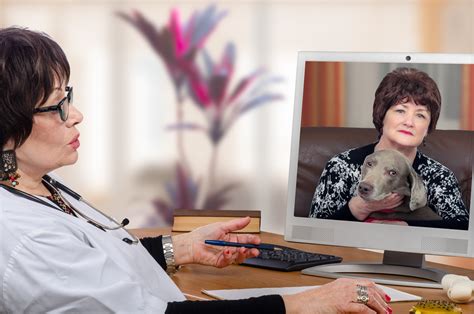Introduction
The veterinary industry is on the cusp of a major transformation, driven by the rapid adoption of telehealth technologies. By 2025, it is estimated that over 50% of all veterinary consultations will be conducted remotely, offering numerous benefits to both pet owners and veterinarians.

Understanding the Need for Telehealth
Pain Points for Pet Owners
- Limited access to veterinary care: Many pet owners live in remote areas or have busy schedules that make it difficult to visit a physical veterinary clinic.
- High costs of in-person consultations: Veterinary care can be expensive, especially for routine checkups or minor illnesses.
- Time-consuming appointments: In-person appointments often require waiting time and travel, which can be inconvenient.
Motivations for Pet Owners
- Convenience: Telehealth allows pet owners to consult with veterinarians from the comfort of their own homes, saving them time and effort.
- Affordability: Telehealth consultations are typically more affordable than in-person visits, making veterinary care more accessible to pet owners.
- Peace of mind: Telehealth enables pet owners to connect with veterinarians quickly and easily, providing peace of mind in case of emergencies or unexpected health concerns.
Benefits of Telehealth for Veterinarians
Pain Points for Veterinarians
- Overcrowded clinics: Traditional veterinary clinics are often overwhelmed with appointments, leading to long wait times and overworked staff.
- Limited resources: Many veterinary clinics lack the specialized equipment or expertise to handle all types of cases.
- Burnout: The high workload and demanding nature of veterinary medicine can contribute to burnout among veterinarians.
Motivations for Veterinarians
- Increased accessibility: Telehealth expands a veterinarian’s reach, allowing them to provide care to pets and pet owners who may not be able to visit a physical clinic.
- Efficiency: Telehealth consultations can be conducted more efficiently than in-person appointments, freeing up veterinarians’ time for more complex cases.
- Improved work-life balance: Telehealth enables veterinarians to work remotely or set flexible hours, improving their work-life balance.
Current Status of Vet Telehealth
The adoption of telehealth in veterinary medicine has been steadily increasing:
- Growth in virtual consultations: The number of virtual veterinary consultations has grown exponentially in recent years, with over 4 million consultations conducted in the United States in 2021.
- Broad range of applications: Telehealth is being used for a wide range of veterinary services, including consultations, medication refills, and specialized care.
- Positive feedback from users: Pet owners and veterinarians alike have reported high levels of satisfaction with telehealth consultations.
Highlights: What Sets Successful Telehealth Providers Apart
- Seamless user experience: Easy-to-use platforms and intuitive interfaces allow for a seamless consultation experience.
- Personalized care: Telehealth providers offer personalized care plans and tailored advice based on each pet’s unique needs.
- Integrated technology: Telehealth platforms integrate with other veterinary software, streamlining communication and medical records management.
Future Applications of Telehealth: Reimagining Vet Care
Beyond current applications, telehealth holds numerous opportunities for future innovation:
- Remote monitoring: Wearable devices and sensors can monitor pets’ vital signs and activity levels, providing veterinarians with valuable data to identify potential health issues.
- Emergency triage: Telehealth consultations can be used to triage emergencies and direct pet owners to the appropriate level of care.
- Remote surgeries: In the future, it may be possible to perform certain surgeries remotely using advanced robotics and telepresence technologies.
Tables for Vet Telehealth and Patient Engagement
Table 1: Benefits of Telehealth for Pet Owners
| Benefit | Description |
|---|---|
| Convenience | Access to veterinary care from home |
| Affordability | Lower consultation costs |
| Peace of mind | Quick access to veterinarians in case of emergencies |
Table 2: Motivations for Veterinarians to Adopt Telehealth
| Motivation | Description |
|---|---|
| Increased accessibility | Reach more pet owners and provide care remotely |
| Efficiency | Free up time for complex cases |
| Improved work-life balance | Work remotely or set flexible hours |
Table 3: Highlights of Successful Telehealth Providers
| Highlight | Description |
|---|---|
| Seamless user experience | Easy-to-use platforms and intuitive interfaces |
| Personalized care | Tailored care plans and advice |
| Integrated technology | Integration with other veterinary software |
Table 4: Future Applications of Telehealth in Veterinary Care
| Application | Description |
|---|---|
| Remote monitoring | Wearable devices and sensors monitor vital signs and activity levels |
| Emergency triage | Triage emergencies and direct pet owners to appropriate care |
| Remote surgeries | Surgeries performed remotely using robotics and telepresence technologies |
Conclusion
Vet telehealth is revolutionizing veterinary care, offering numerous benefits to both pet owners and veterinarians. By 2025, telehealth is expected to become the primary mode of veterinary consultation, transforming the industry and enhancing the lives of pets and their owners.





















